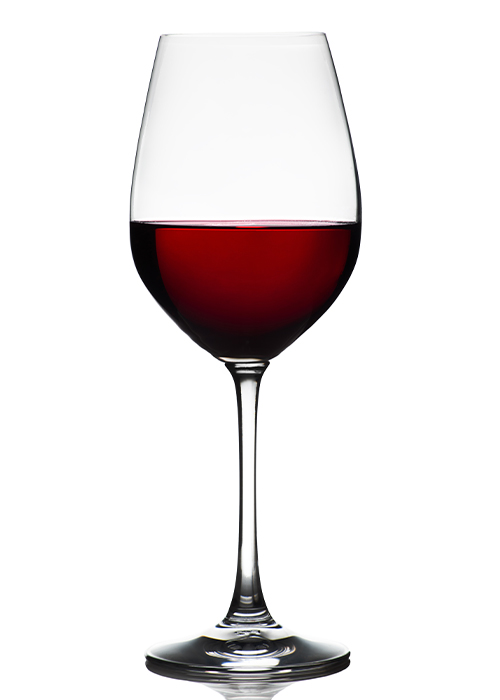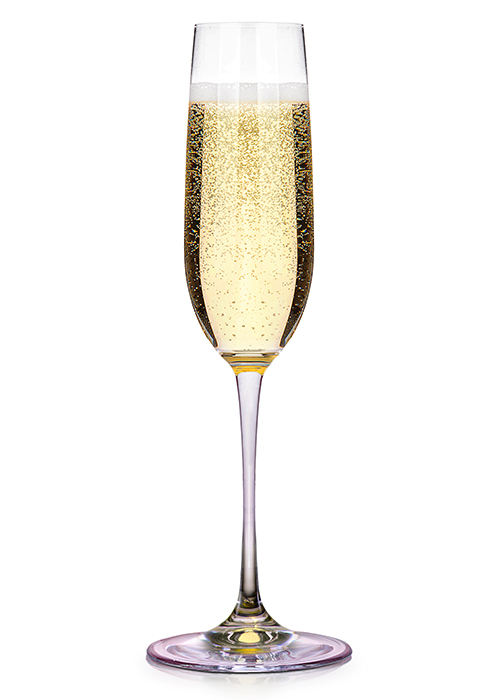It’s easy to dismiss a wine glass as just another piece of tableware, but the shape of a drinking vessel plays an important role in how a wine tastes. The difference between a still wine glass and a flute is readily apparent; the flute with its iconic tall and narrow design is often reserved for Champagne and celebratory events, while the full round bowl of the traditional wine glass is the industry standard for still red and white wines.
Of course, both categories come in varying shapes and sizes — some flutes are tulip-shaped, while some still wine glasses forego the wide bowl for a taller and tapered form.
As it turns out, wine experts have very strong opinions about these two types of stemware that may make streamlining your glass cabinet a bit easier. Keep reading to learn more about how flutes and wine glasses really compare.
Don’t miss a drop!
Get the latest in beer, wine, and cocktail culture sent straight to your inbox.
Origin
The Egyptians and the Mesopotamians are often credited as being the first to use glass as a drinking vessel as far back as the 16th century B.C. But according to the BBC, the wine glass as we know it today — which includes a bowl, stem, and a base — is believed to have been born in Venice, approximately around the year 1400. During this time, artisans known for their glassblowing prowess were kept on the island of Murano by Venetian authorities to ensure that their industry secrets remained hidden from the rest of the world.

The origins of the flute, on the other hand, are a bit murkier. Some sources suggest that the coupe, the flute’s stouter, wide-rimmed sibling paved the way beginning in 17th-century England when it was invented as specialized glassware intended for sipping Champagne. And while the flute had certainly been used prior to the 1950s, its increasing popularity with mid-century drinkers made it into the well-known symbol of refinement that it is today.
Construction
In general, most wine glasses and flutes are made with glass — either hand blown or machine-made. While plastic and acrylic are sometimes used for budget-friendly options, high-end stemware is typically made from crystal, which yields a thinner glass often deemed by experts as optimal for tasting the subtleties in wine.
The volume of a wine glass differs considerably depending on the brand and style. Flutes typically hold around 6 to 8 ounces, while white wine glasses hold on average 8 to 12 ounces and 8 to 22 ounces for red wine.
What the Pros Think
When it comes to drinking sparkling wines, Master of Wine and founder of RAW WINE Isabelle Legeron admits that her varied collection of flutes has been rendered useless. “I find it difficult to drink out of flutes because the aromas tend to be reduced by the small opening of the glass at the top and they don’t give wines the same level of aeration you would get from a normal wine glass,” she says. Legeron adds that using a wine glass for sparkling wine instead of a flute, “makes for a better, more satisfying drinking experience.”

Jen Pelka, the co-founder and CEO of Une Femme Wines and the former owner of The Riddler in NYC and San Francisco, recalls the wise words of Maggie Henríquez, president and CEO of Krug, who told her: “Drinking Champagne from a flute is like going to the symphony with earplugs in. All you can hear are the loudest notes.”
Building on Henríquez’s critique, Pelka continues: “With a flute, the wines never get a chance to open up in any way, and the aromatics are barely perceptible because you can’t get your nose in the glass. You want to drink Champagne out of a wine glass for the same reasons you want to do so with any wine — so you can get a real understanding of the aromatics of the wine, and to oxygenate the wine so that it opens up.”
Further cementing the wine glass’s dominance in this matchup, Zach Morris, the co-owner and wine director of Bloomsday Cafe in Philadelphia, admits that his vote goes to the wine glass every time. “Have you ever tried to get your nose into a flute to sniff a wine? Aromas are the most interesting, nuanced, and important things a wine has to offer,” he says. But he does give the flute points for its elegant appearance and ability to fit a large number on a tray.
Pro Tips
When picking out stemware, Morris likes to buy the cheapest 16-ounce stemmed wine glasses from Crate & Barrel just in case he breaks them. “I get the same size for all colors and types of wine as long as they’re tapered in a little so as to make swirling and sniffing easier,” he adds.
Master sommelier Jonathan Pullis, the wine director at 7908 Aspen, says that when it comes to drinking Champagne (and sparkling wine), “coupes evoke a certain Great Gatsby feel, and are fun for parties,” while flutes offer a “practical option.” But his favorite vessel to use is the Universal glass from Zalto: “Designed by the legendary Aldo Sohm, it’s our go-to for any great wine, be it sparkling or still. Once you hold it, you will understand why!”
For Pelka, a simple switch can make all the difference when dining out: “The next time you go to a restaurant and they automatically bring over a flute, simply ask for an ‘AP glass,’ an all-purpose wine glass that is great for all wines. You’ll likely get better service because of it.”


